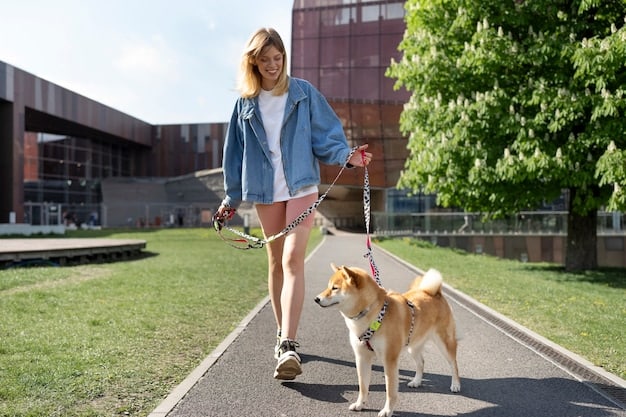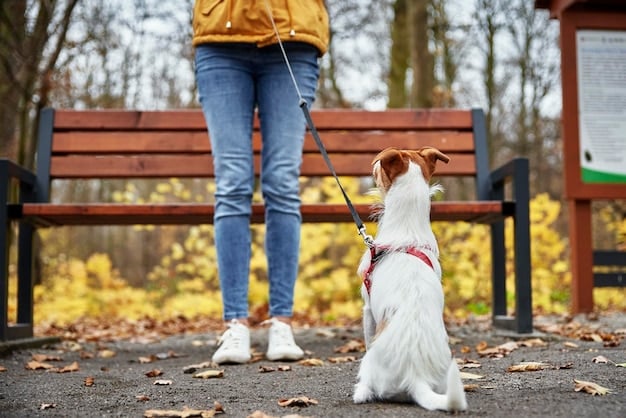Leash Reactivity Breakthrough: Reduce Lunging by 50%

Anúncios
Leash reactivity in dogs, characterized by lunging, barking, and pulling, can be significantly reduced using an updated training protocol that focuses on positive reinforcement and desensitization techniques, potentially decreasing these behaviors by up to 50%.
Is your dog’s leash reactivity making walks a nightmare? Discover the Leash Reactivity Breakthrough: Reduce Lunging by 50% with This Updated Training Protocol, designed to transform stressful outings into enjoyable experiences for both you and your furry friend.
Anúncios
Understanding Leash Reactivity in Dogs
Leash reactivity is a common issue many dog owners face. It’s important to understand what causes this behavior before attempting to correct it. This section will explore the underlying reasons for leash reactivity and how it manifests.
Leash reactivity is not simply disobedience; it’s often rooted in fear, frustration, or excitement. By recognizing these triggers, owners can begin to address the problem more effectively.
Anúncios
Common Causes of Leash Reactivity
Many factors can contribute to a dog’s leash reactivity. Here are some of the most common:
- Fear: A dog may react defensively if it perceives a threat, such as another dog or a stranger.
- Frustration: Some dogs become frustrated by the leash because it restricts their ability to greet others.
- Excitement: An overly excited dog may pull and lunge in an attempt to get closer to something interesting.
- Lack of Socialization: Dogs that haven’t been properly socialized may be more reactive to new stimuli.
Recognizing the Signs of Reactivity
Identifying the early signs of reactivity is crucial for proactive management. These signs can be subtle at first but escalate quickly if not addressed. Being observant of your dog’s body language can help you anticipate and prevent reactive episodes. Look for:
- Stiffening of the body: A tense posture is often the first sign that your dog is becoming alert and possibly reactive.
- Hard stare: A fixed gaze directed at the trigger indicates heightened attention and potential aggression.
- Raised hackles: The hair along the back may stand up in response to fear or excitement.
- Barking or growling: These vocalizations are clear indicators of distress or aggression.
Understanding leash reactivity starts with recognizing the underlying emotions and triggers that cause your dog to react. This foundational knowledge is essential for implementing effective training strategies.
The Updated Training Protocol: A Step-by-Step Guide
This updated training protocol focuses on positive reinforcement and desensitization techniques. It’s designed to help your dog overcome leash reactivity in a gradual and sustainable way.
The protocol involves creating positive associations with triggers and teaching alternative behaviors. Consistency and patience are key to success.

Step 1: Identifying Triggers
The first step is to identify the specific triggers that cause your dog to react. This requires careful observation during walks. Keep a journal to record what sets your dog off.
Triggers may include other dogs, people, cars, bicycles, or even specific locations. The more specific you are, the better you can tailor your training.
Step 2: Creating a Safe Distance
Once you’ve identified your dog’s triggers, the next step is to maintain a safe distance during walks. This means staying far enough away from triggers that your dog doesn’t react.
- Use longer leashes: This gives you more control and allows you to create more distance from triggers.
- Change your route: Avoid areas where triggers are common.
- Walk at off-peak hours: Less crowded times can reduce exposure to triggers.
Step 3: Positive Reinforcement
Positive reinforcement is a cornerstone of this protocol. Reward your dog for calm behavior in the presence of triggers, even if it’s just a glance.
- Use high-value treats: These should be something your dog loves, like small pieces of chicken or cheese.
- Reward calm behavior: When your dog sees a trigger but remains calm, immediately give a treat and praise.
- Be consistent: Always reward calm behavior to reinforce the association.
The step-by-step guide is crucial for successfully implementing the training protocol. Identifying triggers, creating safe distances, and using positive reinforcement are essential components of this approach.
Desensitization and Counter-Conditioning Techniques
Desensitization and counter-conditioning are powerful techniques for changing your dog’s emotional response to triggers. They work by gradually exposing your dog to triggers in a controlled environment while creating positive associations.
These techniques require patience and consistency. It’s important to proceed at your dog’s pace and avoid overwhelming them.
What is Desensitization?
Desensitization involves gradually exposing your dog to a trigger at a low intensity, where they don’t react. The goal is to reduce their sensitivity to the trigger over time. This can be achieved by:
- Start at a distance: Begin with the trigger far enough away that your dog remains calm.
- Gradually decrease the distance: As your dog becomes more comfortable, slowly decrease the distance to the trigger.
- Monitor your dog’s body language: Watch for signs of stress, and adjust the distance accordingly.
What is Counter-Conditioning?
Counter-conditioning involves changing your dog’s emotional response to a trigger by pairing it with something positive, such as a treat. The goal is to create a positive association with the trigger.
- Pair the trigger with a treat: When your dog sees a trigger, immediately give them a treat.
- Repeat the process: Continue pairing the trigger with a treat over multiple sessions.
- Monitor your dog’s response: Watch for signs that your dog is starting to associate the trigger with something positive.
Desensitization and counter-conditioning work hand in hand. By gradually exposing your dog to triggers and creating positive associations, you can change their emotional response and reduce leash reactivity.
Troubleshooting Common Challenges
Even with the best training protocol, challenges can arise. This section addresses common issues and provides solutions to help you overcome them.
It’s important to remember that every dog is different, and what works for one may not work for another. Be patient and adaptable.
Dealing with Setbacks
Setbacks are a normal part of the training process. If your dog has a reactive episode, don’t get discouraged. Instead:
- Increase the distance: Go back to a distance where your dog feels comfortable.
- Reassess your approach: Consider whether you’re moving too quickly or if the trigger is too intense.
- Seek professional help: A certified dog trainer or behaviorist can provide personalized guidance.
Managing High-Arousal Situations
Some situations can be particularly challenging, such as encountering multiple triggers at once. In these cases:
High-Arousal Situations can be difficult to manage effectively to ensure a safe environment.
- Try to avoid them: If possible, steer clear of areas where high-arousal situations are likely to occur.
- Use management tools: Head halters or front-clip harnesses can give you more control.
- Stay calm: Your dog will pick up on your emotions, so try to remain calm and confident.
When to Seek Professional Help
If you’re struggling to make progress, don’t hesitate to seek professional help. A certified dog trainer or behaviorist can assess your dog’s specific needs and develop a tailored training plan.
Troubleshooting common challenges is an integral part of the training process. Setbacks, high-arousal situations, and the need for professional help are all normal aspects of addressing leash reactivity.
Measuring Progress and Setting Realistic Goals
Tracking your dog’s progress is essential for staying motivated and making adjustments to the training protocol. Setting realistic goals will help you stay on track and avoid frustration.
Remember that progress may not be linear. There will be good days and bad days. The key is to focus on the overall trend.

How to Track Progress
Keeping a detailed record of your dog’s behavior can provide valuable insights. Consider tracking:
- Frequency of reactive episodes: How often does your dog react on walks?
- Intensity of reactions: How severe are the reactions?
- Triggers: What specific triggers are causing the most problems?
Setting Realistic Goals
It’s important to set goals that are achievable and measurable. Start with small steps and gradually increase the challenge.
Celebrate small victories along the way. Positive reinforcement for both you and your dog can make the training process more enjoyable.
Celebrating Successes
Recognize and celebrate your dog’s successes, no matter how small. This will help to reinforce positive behavior and keep you motivated.
- Give praise and treats: Reward your dog for calm behavior and progress toward your goals.
- Take breaks: Short, positive training sessions are more effective than long, tiring ones.
- Enjoy the process: Remember that training is an ongoing journey. Enjoy the bond you’re building with your dog.
Measuring progress and setting realistic goals are essential for long-term success. Tracking behavior, setting achievable goals, and celebrating successes will keep you and your dog motivated throughout the training process.
Maintaining Long-Term Success
Once your dog has made progress in overcoming leash reactivity, it’s important to maintain that progress long-term. This requires ongoing management and reinforcement.
Consistency is key. Continue to practice the techniques you’ve learned and be vigilant about managing triggers.
Ongoing Management
Even after your dog has improved, it’s important to continue managing their environment to minimize exposure to triggers. This may involve:
- Avoiding high-traffic areas: Choose quieter routes for walks.
- Using management tools: Continue using head halters or front-clip harnesses if they’re helpful.
- Being aware of your surroundings: Scan your environment for potential triggers and be prepared to react.
Reinforcement Training
Regular reinforcement training can help to maintain your dog’s progress and prevent regression. This involves:
Reinforcement training should become a lifestyle, if possible, to maintain long-term success.
- Practicing recall: A reliable recall can help you to remove your dog from potentially reactive situations.
- Reinforcing calm behavior: Continue to reward your dog for calm behavior in the presence of triggers.
- Varying your training: Keep things interesting by introducing new challenges and rewards.
Maintaining long-term success requires ongoing management and reinforcement. By continuing to practice the techniques you’ve learned and being vigilant about managing triggers, you can help your dog maintain their progress and enjoy calmer, more enjoyable walks.
| Key Point | Brief Description |
|---|---|
| 💡 Identify Triggers | Determine what causes your dog’s reactive behavior. |
| 🛡️ Safe Distance | Keep enough space to prevent reactive episodes. |
| 🐾 Positive Reinforcement | Reward calm behavior with treats and praise. |
| 📈 Track Progress | Monitor behavior and adjust the training as needed. |
FAQ
▼
Leash reactivity refers to a dog’s exaggerated reactions, such as barking, lunging, or pulling, when on a leash and encountering specific triggers like other dogs or people. It’s often rooted in fear, frustration, or over-excitement.
▼
The timeline for improvement varies depending on the dog’s temperament, the severity of the reactivity, and the consistency of the training. Some dogs show progress in weeks, while others may take months.
▼
Use high-value treats that your dog loves and finds particularly motivating. Small pieces of cooked chicken, cheese, or commercial training treats are often effective. Rotate treats to keep things interesting.
▼
If reactivity worsens, reassess your approach. Ensure you’re not overwhelming your dog and maintain a safe distance from triggers. Consider seeking guidance from a professional dog trainer or behaviorist.
▼
While complete “cures” can be rare, significant improvements are possible with consistent training and management. The goal is to help your dog manage their emotions and react more calmly in challenging situations.
Conclusion
By understanding the causes of leash reactivity and implementing the updated training protocol, you can make significant progress in reducing your dog’s lunging and other reactive behaviors. Remember to be patient, consistent, and celebrate every success along the way. With dedication and the right approach, you and your furry friend can enjoy calmer, more pleasant walks.






